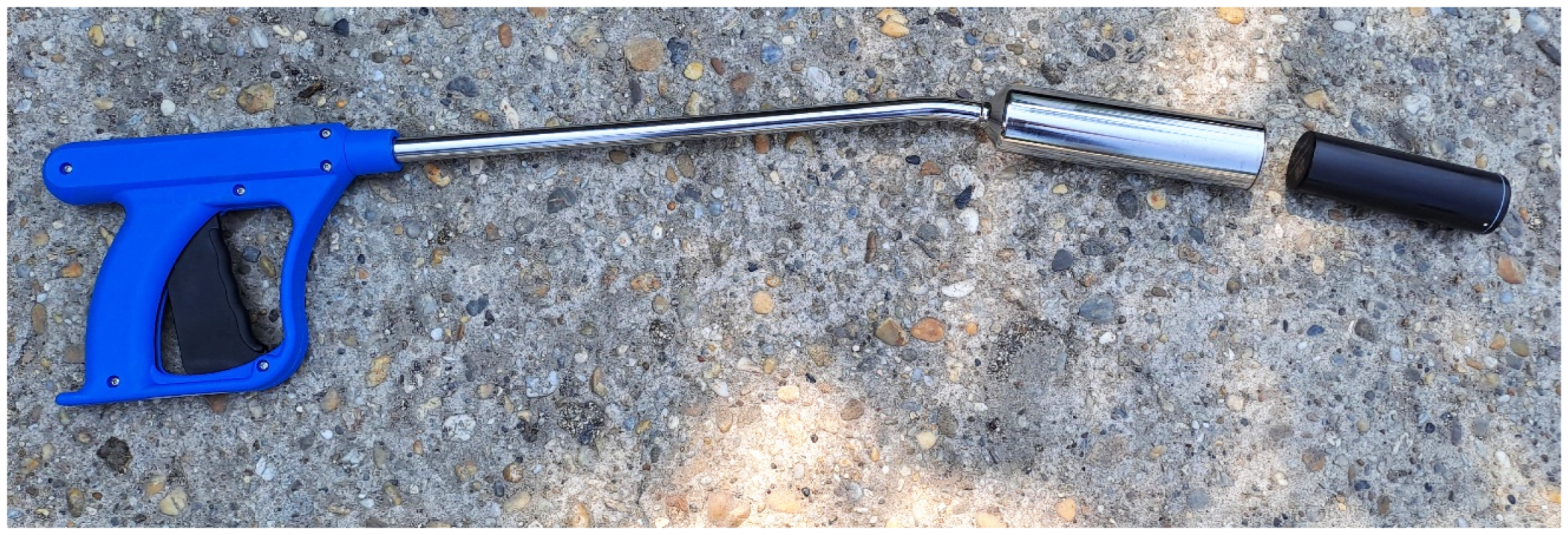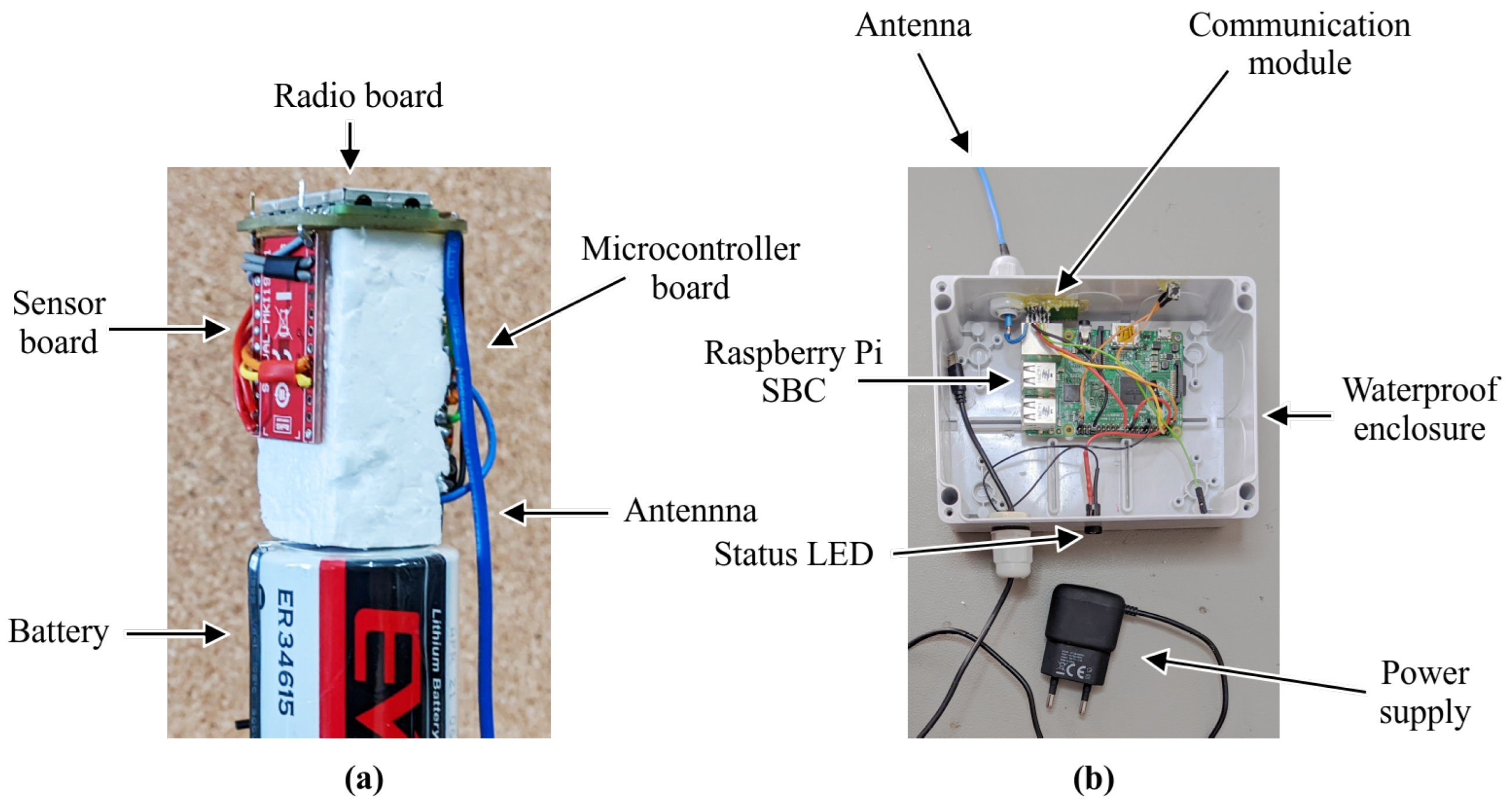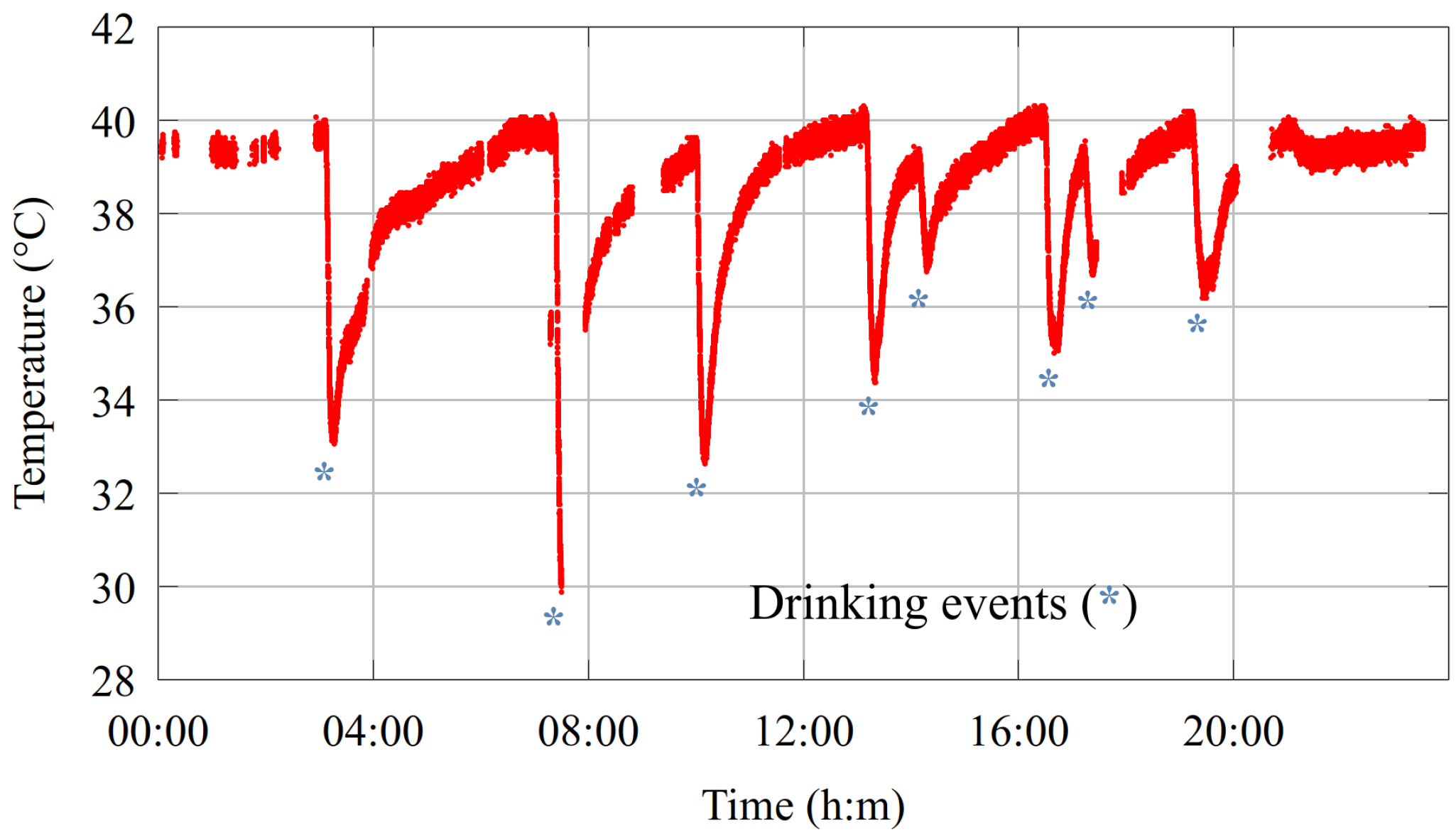In-Depth Development of a Versatile Rumen Bolus Sensor for Dairy Cattle
Abstract
1. Introduction
2. System Design
2.1. Requirements
2.2. System Architecture
2.3. Mechanical Design and Power Source
2.4. Sensors
2.5. Communication Design
3. Results
3.1. Hardware
3.1.1. Experimental Bolus
3.1.2. Final Bolus Design
- Packet ID
- Compensated body temperature
- Drinking counter
- Cumulated activity counters
- Peak activity values
- Rumination counter
- Heart rate values
- Maintenance data (firmware version, system status, battery voltage)
3.2. Software
3.2.1. Embedded Firmware
3.2.2. Drinking Detection Algorithm
| Algorithm 1: Drinking Detection |
Initialization remaining samples to the next possible drinking event last measured temperature drinking event counter Input t temperature For each sample: 1 if and 2 3 4 if 5 6 |
3.2.3. Motion Activity Detection Algorithm
- General Motion: The motion of the animal produces larger, mostly aperiodic values. These variations occur due to activities such as walking, running, or sudden movements.
- Heartbeat: The effect of the heartbeats produces smaller, periodic changes in the accelerometer readings. These subtle variations are indicative of the animal’s cardiovascular activity.
- Rumination: Rumination creates a very specific pattern, which is associated with the repetitive chewing and digestive processes of the animal.
3.2.4. Rumination Detection Algorithm
- The active state starts, when passes the high threshold (default value: 3500).
- The passive state starts, when falls under the low threshold (default value: 6000).
- The active period is accepted when its length falls into a predefined interval.
- The active-passive period pair is accepted when their total length falls into a predefined interval and the relative difference between the k consecutive interval lengths is lower than . The default value for and are 50 and 100 s, or 625 and 1250 samples, respectively. The default value for k and are 5 and 0.2, respectively.
| Algorithm 2: Rumination Detection |
Initialization activity state sample number of the start of the last active period sample number of the end of the last active period sample number of the end of the last passive period buffer for period lengths, stores k values, FIFO type cumulated rumination ongoing rumination Input t sample number enveloped intensity value For each sample: 1 if 2 3 4 5 6 if 7 8 9 else 10 append 11 if 12 if o = 0 13 c = c + sum(L) 14 o = 1 15 else 16 c = c + l 17 if 18 19 20 21 if 22 23 |
3.2.5. Heart Rate (HR) Measurement Algorithm
3.2.6. Fever and Thermal Shock Detection Algorithm
3.2.7. Oestrus Prediction Algorithm
4. Discussion
- Through post-processing of the heart rate data, it is possible to obtain valid data free of the influence of false periods. Furthermore, data processing should incorporate data from the sensor in the stable, as well as data from the animal administration systems, including expected estrus, medication, and other relevant variables.
- An elevated temperature in the rumen may also indicate increased fermentation activity. However, when this is considered alongside the time spent ruminating and the temperature in the barn, valuable information about fever can be obtained. The same data can be used to infer heat stress by comparing them with stable humidity and temperature.
- The detection of estrus on the server side is feasible based on the analysis of movement activity and temperature data.
- The combination of activity and drinking data enables the detection of calving events. Complex monitoring of the animal may indicate the presence of additional health issues, including disease and lameness, through the observation of altered behavioral patterns.
- At present, there is no pH measurement sensor that allows for long-term monitoring. The introduction of such a device would confer a significant advantage to rumen boluses over other sensors, given the paramount importance of rumen pH measurement and the inability to achieve it through alternative means.
- The necessity for a more comprehensive understanding of the quantity of greenhouse gases emitted by cows and the means of controlling this level in animal husbandry is increasing. Consequently, it is anticipated that in the future, the development of boluses for the detection of methane gas will receive significant attention.
- The issue of feed utilization is of significant importance, and it is reasonable to anticipate the advent of related measurements in the future.
- Digital twinning is a simulation and visualization environment that provides real-time data from the actual operation of systems, allowing for the visualization and monitoring of these systems from a multitude of perspectives. Such systems are currently utilized in industrial contexts, yet their application in agricultural settings is still in its infancy. However, their advent is anticipated [53].
Author Contributions
Funding
Institutional Review Board Statement
Informed Consent Statement
Data Availability Statement
Acknowledgments
Conflicts of Interest
References
- Knight, C.H. Review: Sensor techniques in ruminants: More than fitness trackers. Animal 2020, 14, S187–S195. [Google Scholar] [CrossRef]
- Berckmans, D. Precision livestock farming. Comput. Electron. Agric. 2008, 62, 1. [Google Scholar] [CrossRef]
- Berckmans, D. Precision livestock farming technologies for welfare management in intensive livestock systems. Rev. Sci. Tech. 2014, 33, 189–196. [Google Scholar] [CrossRef]
- Cabrera, V.E.; Fadul-pacheco, L. Future of dairy farming from the Dairy Brain perspective: Data integration, analytics, and applications. Int. Dairy J. 2021, 121, 105069. [Google Scholar] [CrossRef]
- Caja, G.; Castro-Costa, A.; Knight, C.H. Engineering to support wellbeing of dairy animals. J. Dairy Res. 2016, 83, 136–147. [Google Scholar] [CrossRef]
- Daum, T.; Ravichandran, T.; Kariuki, J.; Chagunda, M.; Birner, R. Connected cows and cyber chickens? Stocktaking and case studies of digital livestock tools in Kenya and India. Agric. Syst. 2022, 196, 103353. [Google Scholar] [CrossRef]
- El Bilali, H.; Bottalico, F.; Ottomano Palmisano, G.; Capone, R. Information and communication technologies for smart and sustainable agriculture. In 30th Scientific-Experts Conference of Agriculture and Food Industry: Answers for Forthcoming Challenges in Modern Agriculture; Springer: Cham, Switzerland, 2020; Volume 78, pp. 321–334. [Google Scholar] [CrossRef]
- Michie, C.; Andonovic, I.; Davison, C.; Hamilton, A.; Tachtatzis, C.; Jonsson, N.; Duthie, C.A.; Bowen, J.; Gilroy, M. The internet of things enhancing animal welfare and farm operational efficiency. J. Dairy Res. 2020, 87, 20–27. [Google Scholar] [CrossRef]
- Beszédes, B.; Széll, K.; Györök, G. A Highly Reliable, Modular, Redundant and Self-Monitoring PSU Architecture. Acta Polytech. Hung. 2020, 17, 233–249. [Google Scholar] [CrossRef]
- Gu, J.Q.; Wang, Z.H.; Gao, R.H.; Wu, H.R. Cow behavior recognition based on image analysis and activities. Int. J. Agric. Biol. Eng. 2017, 10, 165–174. [Google Scholar] [CrossRef]
- Alzahal, O.; Steele, M.A.; Valdes, E.V.; Mcbride, B.W. Technical note: The use of a telemetric system to continuously monitor ruminal temperature and to predict ruminal pH in cattle. J. Dairy Sci. 2009, 92, 5697–5701. [Google Scholar] [CrossRef]
- Borchers, M.R.; Chang, Y.M.; Proudfoot, K.L.; Wadsworth, B.A.; Stone, A.E.; Bewley, J.M. Machine-learning-based calving prediction from activity, lying, and ruminating behaviors in dairy cattle. J. Dairy Sci. 2017, 100, 5664–5674. [Google Scholar] [CrossRef]
- Ledgerwood, D.N.; Winckler, C.; Tucker, C.B. Evaluation of data loggers, sampling intervals, and editing techniques for measuring the lying behavior of dairy cattle. J. Dairy Sci. 2010, 93, 5129–5139. [Google Scholar] [CrossRef]
- Alsaaod, M.; Römer, C.; Kleinmanns, J.; Hendriksen, K.; Rose-Meierhöfer, S.; Plümer, L.; Büscher, W. Electronic detection of lameness in dairy cows through measuring pedometric activity and lying behavior. Appl. Anim. Behav. Sci. 2012, 142, 134–141. [Google Scholar] [CrossRef]
- Nagl, L.; Schmitz, R.; Warren, S.; Hildreth, T.; Erickson, H.; Andresen, D. Wearable sensor system for wireless state-of-health determination in cattle. In Proceedings of the 25th Annual International Conference of the IEEE Engineering in Medicine and Biology Society (IEEE Cat. No. 03CH37439), Cancun, Mexico, 17–21 September 2003; Volume 4, pp. 3012–3015. [Google Scholar]
- SmaxTec. Available online: https://smaxtec.com/en/smaxtec-system-in-detail/ (accessed on 27 June 2024).
- Hokofarm Group. Available online: https://hokofarmgroup.com/ (accessed on 27 June 2024).
- Moonsyst. Moonsyst Cattle Monitoring. Available online: https://moonsyst.com/bolus (accessed on 2 April 2023).
- Ghirardi, J.; Caja, G.; Garín, D.; Casellas, J.; Hernández-Jover, M. Evaluation of the retention of electronic identification boluses in the forestomachs of cattle. J. Anim. Sci. 2006, 84, 2260–2268. [Google Scholar] [CrossRef]
- Nagyné Hajnal, É.; Kovács, L.; Vakulya, G.; Hajnal, É.; Kovács, L.; Vakulya, G. Dairy Cattle Rumen Bolus Developments with Special Regard to the Applicable Artificial Intelligence (AI) Methods. Sensors 2022, 22, 6812. [Google Scholar] [CrossRef]
- Ruiz-Garcia, L.; Lunadei, L. The role of RFID in agriculture: Applications, limitations and challenges. Comput. Electron. Agric. 2011, 79, 42–50. [Google Scholar] [CrossRef]
- Mottram, T.T. Is A Lifetime Rumen Monitoring Bolus Possible? 2010. Available online: http://precisiondairy.com/proceedings/s11mottram.pdf (accessed on 2 April 2023).
- Zhang, L.; Lu, J.; Nogami, H.; Okada, H.; Itoh, T.; Arai, S. Solid-state pH sensor prototype for real-time monitoring of the rumen pH value of Japanese cows. Microsyst. Technol. 2018, 24, 457–463. [Google Scholar] [CrossRef]
- Mottram, T.; Lowe, J.; McGowan, M.; Phillips, N. A wireless telemetric method of monitoring clinical acidosis in dairy cows. Comput. Electron. Agric. 2008, 64, 45–48. [Google Scholar] [CrossRef]
- Sato, S.; Mizuguchi, H.; Ito, K.; Ikuta, K.; Kimura, A.; Okada, K. Technical note: Development and testing of a radio transmission pH measurement system for continuous monitoring of ruminal pH in cows. Prev. Vet. Med. 2012, 103, 274–279. [Google Scholar] [CrossRef] [PubMed]
- Dogan, H.; Yavuz, M. A new wireless bolus sensor with active RFID tag to measure rumen pH. Fresenius Environ. Bull. 2018, 27, 1031–1037. [Google Scholar]
- Lokhorst, C. Practical experiences of IoT applications in the IoF2020 Dairy Trial. In Practical Precision Livestock Farming; Banhazi, T., Halas, V., Maroto-Molina, F., Eds.; Wageningen Academic: Wageningen, The Netherlands, 2023; pp. 269–292. [Google Scholar]
- D’Alessandro, A.G.; De Palo, P.; Maggiolino, A.; Mele, M. ASPA 25th Congress Book of Abstract. Ital. J. Anim. Sci. 2023, 22, 1–320. [Google Scholar] [CrossRef]
- Ammer, S.; Lambertz, C.; Gauly, M. Is reticular temperature a useful indicator of heat stress in dairy cattle? J. Dairy Sci. 2016, 99, 10067–10076. [Google Scholar] [CrossRef] [PubMed]
- Džermeikait, K. Innovations in Cattle Farming: Application of Innovative. Animals 2023, 13, 780. [Google Scholar] [CrossRef] [PubMed]
- Lees, A.M. Evaluating rumen temperature as an estimate of core body temperature in Angus feedlot cattle during summer. Int. J. Biometeorol. 2019, 63, 939–947. [Google Scholar] [CrossRef] [PubMed]
- Vázquez-Diosdado, J.A.; Miguel-Pacheco, G.G.; Plant, B.; Dottorini, T.; Green, M.; Kaler, J. Developing and evaluating threshold-based algorithms to detect drinking behavior in dairy cows using reticulorumen temperature. J. Dairy Sci. 2019, 102, 10471–10482. [Google Scholar] [CrossRef]
- Nagyné Hajnal, É.; Vakulya, G.; Udvardy, P. Long Term Rumen Temperature Analysis of Dairy Cattle with Help of Bolus Sensor. In Proceedings of the AIS 2022—17th International Symposium on Applied Informatics and Related Areas—Proceedings, Székesfehérvár, Hungary, 17 November 2022; pp. 12–16. [Google Scholar]
- Hanušovský, O.; Bíro, D.; Šimko, M.; Gálik, B.; Juráček, M.; Rolinec, M.; Herkeľ, R. Drinking regime evaluation with continuous ruminal monitoring boluses. Acta Fytotech. Zootech. 2017, 20, 1–5. [Google Scholar] [CrossRef]
- Ipema, A.H.; Goense, D.; Hogewerf, P.H.; Houwers, H.W.; van Roest, H. Pilot study to monitor body temperature of dairy cows with a rumen bolus. Comput. Electron. Agric. 2008, 64, 49–52. [Google Scholar] [CrossRef]
- Riaboff, L.; Shalloo, L.; Smeaton, A.F.; Couvreur, S.; Madouasse, A.; Keane, M.T. Predicting livestock behaviour using accelerometers: A systematic review of processing techniques for ruminant behaviour prediction from raw accelerometer data. Comput. Electron. Agric. 2022, 192, 106610. [Google Scholar] [CrossRef]
- Arai, S.; Okada, H.; Sawada, H.; Takahashi, Y.; Kimura, K.; Itoh, T. Evaluation of ruminal motility in cattle by a bolus-type wireless sensor. J. Vet. Med. Sci. 2019, 81, 1835–1841. [Google Scholar] [CrossRef]
- Benaissa, S.; Nikolayev, D.; Vermeeren, G.; Deprez, K.; Goethals, J.; Sonck, B.; Tuyttens, F.A.M.; Martens, L.; Plets, D.; Joseph, W.; et al. Design and Experimental Validation of a Multiband Conformal Patch Antenna for Animal-Ingestible Bolus Applications. IEEE Trans. Antennas Propag. 2023, 71, 6365–6377. [Google Scholar] [CrossRef]
- Alexy, M.; Biszkup, M.; Barkó, B.; Balogh, P.; Márton, A.; Pajor, G.; Szabó, S.; Molnár, B. Digital solutions for tracking livestock movement in outdoor farming systems. In Proceedings of the IEEE (Szerk.), 2nd International Conference on Cognitive Mobility (CogMob), Budapest, Hungary, 19–20 October 2023; pp. 10–16. [Google Scholar]
- Ghassemi Nejad, J.; Ju, M.S.; Jo, J.H.; Oh, K.H.; Lee, Y.S.; Lee, S.D.; Kim, E.J.; Roh, S.; Lee, H.G. Advances in Methane Emission Estimation in Livestock: A Review of Data Collection Methods, Model Development and the Role of AI Technologies. Animals 2024, 14, 435. [Google Scholar] [CrossRef] [PubMed]
- Tsakiridis, N.L.; Diamantopoulos, T.; Symeonidis, A.L.; Theocharis, J.B.; Iossifides, A.; Chatzimisios, P.; Pratos, G.; Kouvas, D. Versatile Internet of Things for Agriculture: An eXplainable AI Approach. In Artificial Intelligence Applications and Innovations; Maglogiannis, I., Iliadis, L., Pimenidis, E., Eds.; Springer: Cham, Switzerland, 2020; pp. 180–191. [Google Scholar]
- Kovács, L.; Jurkovich, V.; Bakony, M.; Szenci, O.; Póti, P.; Tozsér, J. Welfare implication of measuring heart rate and heart rate variability in dairy cattle: Literature review and conclusions for future research. Animal 2014, 8, 316–330. [Google Scholar] [CrossRef] [PubMed]
- Kovács, L.; Kézér, F.L.; Ruff, F.; Jurkovich, V.; Szenci, O. Heart rate, cardiac vagal tone, respiratory rate, and rectal temperature in dairy calves exposed to heat stress in a continental region. Int. J. Biometeorol. 2018, 62, 1791–1797. [Google Scholar] [CrossRef] [PubMed]
- Lee, M.; Seo, S. Wearable wireless biosensor technology for monitoring cattle: A review. Animals 2021, 11, 2779. [Google Scholar] [CrossRef]
- Routray, S.K.; Mohanty, S. Principles and Applications of Narrowband Internet of Things (NBIoT); IGI Global: Hershey, PA, USA, 2021. [Google Scholar]
- Pagano, A.; Croce, D.; Tinnirello, I.; Vitale, G. A survey on LoRa for smart agriculture: Current trends and future perspectives. IEEE Internet Things J. 2022, 10, 3664–3679. [Google Scholar] [CrossRef]
- POM-C. POM-C Usage. Available online: https://www.ensingerplastics.com/en/shapes/acetal-tecaform-ah-black#/product-technical-detail-collapse-item-3-lvl-1 (accessed on 2 April 2023).
- Curone, D.; Tognetti, A.; Secco, E.L.; Anania, G.; Carbonaro, N.; De Rossi, D.; Magenes, G. Heart rate and accelerometer data fusion for activity assessment of rescuers during emergency interventions. IEEE Trans. Inf. Technol. Biomed. 2010, 14, 702–710. [Google Scholar] [CrossRef]
- Vakulya, G.; Hajnal, É.; Udvardy, P. Experimental Bolus Sensor for Dairy Cattle. In Proceedings of the 2022 IEEE 20th Jubilee International Symposium on Intelligent Systems and Informatics (SISY), Subotica, Serbia, 15–17 September 2022; pp. 000157–000162. [Google Scholar]
- Hajnal, É.; Vakulya, G.; Udvardy, P. Heart Rate (HR) Detection by Cattle Rumen Bolus. In Proceedings of the 2023 IEEE 27th International Conference on Intelligent Engineering Systems (INES), Nairobi, Kenya, 26–28 July 2023; pp. 000155–000160. [Google Scholar]
- Mohr, E.; Langbein, J.; Nürnberg, G. Heart rate variability: A noninvasive approach to measure stress in calves and cows. Physiol. Behav. 2002, 75, 251–259. [Google Scholar] [CrossRef]
- Hagen, K.; Langbein, J.; Schmied, C.; Lexer, D.; Waiblinger, S. Heart rate variability in dairy cows—Influences of breed and milking system. Physiol. Behav. 2005, 85, 195–204. [Google Scholar] [CrossRef]
- Neethirajan, S.; Kemp, B. Digital twins in livestock farming. Animals 2021, 11, 1008. [Google Scholar] [CrossRef]











Disclaimer/Publisher’s Note: The statements, opinions and data contained in all publications are solely those of the individual author(s) and contributor(s) and not of MDPI and/or the editor(s). MDPI and/or the editor(s) disclaim responsibility for any injury to people or property resulting from any ideas, methods, instructions or products referred to in the content. |
© 2024 by the authors. Licensee MDPI, Basel, Switzerland. This article is an open access article distributed under the terms and conditions of the Creative Commons Attribution (CC BY) license (https://creativecommons.org/licenses/by/4.0/).
Share and Cite
Vakulya, G.; Hajnal, É.; Udvardy, P.; Simon, G. In-Depth Development of a Versatile Rumen Bolus Sensor for Dairy Cattle. Sensors 2024, 24, 6976. https://doi.org/10.3390/s24216976
Vakulya G, Hajnal É, Udvardy P, Simon G. In-Depth Development of a Versatile Rumen Bolus Sensor for Dairy Cattle. Sensors. 2024; 24(21):6976. https://doi.org/10.3390/s24216976
Chicago/Turabian StyleVakulya, Gergely, Éva Hajnal, Péter Udvardy, and Gyula Simon. 2024. "In-Depth Development of a Versatile Rumen Bolus Sensor for Dairy Cattle" Sensors 24, no. 21: 6976. https://doi.org/10.3390/s24216976
APA StyleVakulya, G., Hajnal, É., Udvardy, P., & Simon, G. (2024). In-Depth Development of a Versatile Rumen Bolus Sensor for Dairy Cattle. Sensors, 24(21), 6976. https://doi.org/10.3390/s24216976






